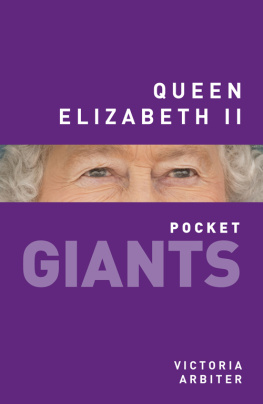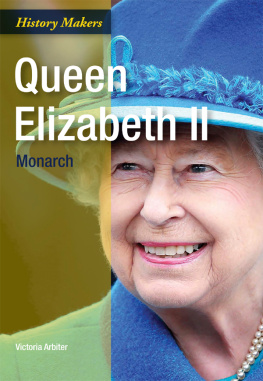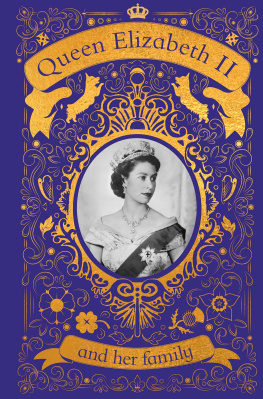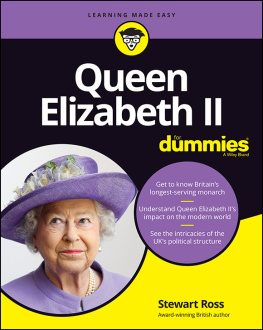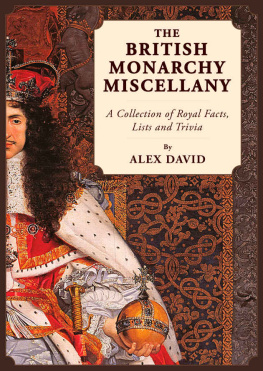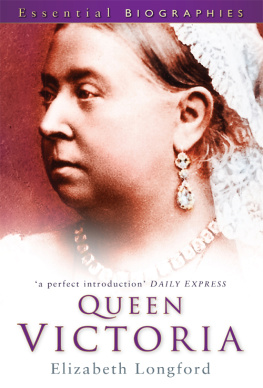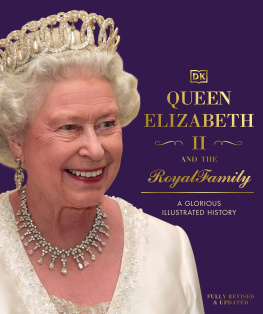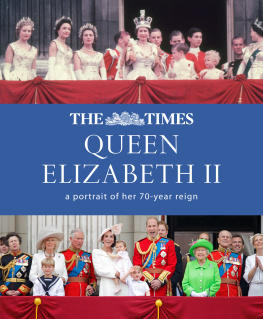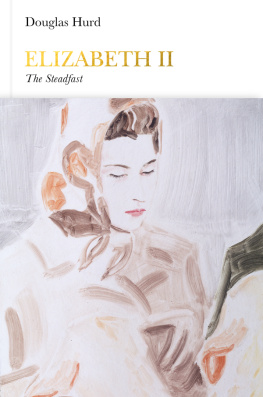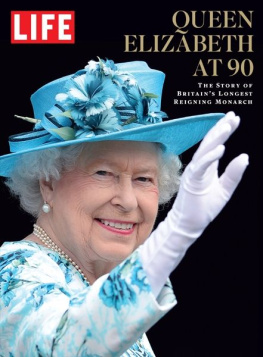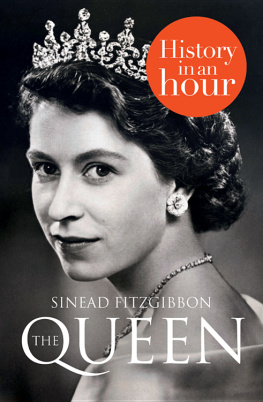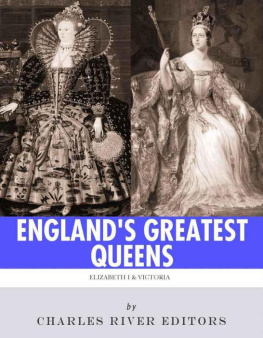Thank you to Rosemary Arbiter, Tony Burton, Marlene Koenig and William Rycroft for your ever-present brilliance. My thanks to Tony Morris for delivering deadlines, critiques and notes in such a positive and encouraging fashion. Its been a delight. Profound gratitude to my father, Dickie Arbiter, for parking my 6-year-old self atop the LBC News van for Trooping the Colour where it all began. And finally, my thanks to Ryan and Raff Brown, with whom all things really are possible.
Introduction
I have to be seen to be believed.
Elizabeth II, tour to New Zealand,
March 1970
Descending the stairs of the royal plane at London Airport on 7 February 1952, the former Princess Elizabeth took her first steps on British soil as queen. She was 25. Only days earlier, her parents, King George VI and Queen Elizabeth, along with her sister, Princess Margaret, had joined a crowd 3000-strong to bid farewell to their eldest daughter and her husband, the Duke of Edinburgh, as they pepared to depart for a five-month tour of Australia and New Zealand. Due to her fathers declining health, Elizabeth had already represented him at a number of public engagements, and had only recently returned from a tour to Canada on his behalf, but in early 1952, as the kings condition showed signs of improvement, it was decided that he was well enough for the young princess to embark on a tour that would see her travel 30,000 miles across four continents.
After sharing a private goodbye on board the aircraft, the royal family returned to the tarmac. With a final wave from the king, the door closed and the plane began its taxi. It was the last time Elizabeth saw her father. Six days later, on 6 February, during the couples stay at Treetops Hotel in Kenya, the first stop on the tour, a Reuters press flash alerted the accompanying media that the king had died in his sleep at Sandringham early that morning. He was 56. At 2.45 p.m. local time, once the princess private secretary, Martin Charteris, had confirmed the news, Prince Philip informed Elizabeth of her fathers death. Following a nineteen-hour flight, the royal plane landed back at London Airport where a small group of Elizabeths ministers, led by her uncle, the Duke of Gloucester, and Prime Minister Winston Churchill, waited to greet her. The royal couple drove to Clarence House in a car bearing the Sovereigns Arms, and the next day, 8 February 1952, the accession of Her Majesty Queen Elizabeth II was proclaimed.
At the time of her birth Princess Elizabeth was never expected to ascend the throne. Were it not for the 1936 abdication of her uncle, Edward VIII, the monarchy as it exists today would be very different indeed. Edward was never crowned and his reign lasted a mere 325 days. Had he fulfilled his kingly duties he would have been required to marry and provide an heir and a spare, but his infatuation with twice-divorced American socialite, Wallis Simpson, and subsequent abdication led to an unprecedented and dramatic shift within the House of Windsor. As his brothers successor, King George VI renewed the general populaces faith in the centuries-old institution, which had been badly shaken as a result of Edwards actions. In turn he proved himself to be far better suited to the role of kingship than his elder brother. Re-establishing a sense of national unity, he led his country through the war years, and his popularity in life gave way to public affection for Elizabeth upon his death.
Most Britons alive today have never known any other sovereign, and with more than sixty years as head of the worlds most famous family, it is hard for many to imagine a Britain in which Elizabeth II is not the head of state. She is the nations fortieth monarch and only the sixth queen since William the Conqueror took the crown more than a thousand years ago. As Britains longest reigning monarch having surpassed Queen Victorias record on 9 September 2015 she is also the countrys longest-lived monarch, as well as the worlds oldest-serving sovereign. In addition to the UK, she is head of state to fifteen other nations known as the Realms and serves as the symbolic leader of the fifty-three-member Commonwealth of Nations. Unlike her mother, she has never been viewed as the nations favourite twinkly eyed granny.
Elizabeths reign has granted the country stability and continuity; she has presided over many of the greatest socio-economic changes of the twentieth century. Her rule has spanned twelve British prime ministers, twelve US presidents and seven popes. At the request of her government she has had dealings with countless global leaders and political heroes and villains including presidents Gorbachev, Eisenhower and Mugabe, South African leader Nelson Mandela, Indian prime minister Indira Gandhi, Romanian dictator Nicolae Ceausescu and IRA commander Martin McGuiness. Over the course of the twentieth century she has signed documents giving independence to hundreds of millions of citizens across the world, and yet it is on the domestic front that she has overseen many of the monarchys most significant reforms. During her sovereignty the royal family has overhauled its personal finances, resulting in a 1992 agreement for the queen to start paying income tax. In 2011, Elizabeth approved changes to the laws to succession, allowing first-born daughters to take precedence over younger-born brothers, as well as permitting future heirs to marry Roman Catholics (even if they themselves may not convert to Catholicism). These sweeping modifications, long overdue in the eyes of many critics, put an end to laws dating back over 300 years. In 2013, before a global press, Elizabeth signed the historic Commonwealth Charter a single document unanimously approved by members of the Commonwealth setting out the core values of the organisation and demanding equality for all.
In 1958 the queen abolished the presentation of the debutantes, which had historically marked the start to the social season. Later she made the walkabout the norm, embraced the world of social media and, in 1993, agreed to open Buckingham Palace to the paying public for a few months of the year. Today the monarchy, although considered aloof and out of touch by some observers, has its own website and Facebook account, not to mention a presence on YouTube, Flickr and Instagram. The announcement of Prince Georges birth in July 2013 was placed on an easel in the forecourt of Buckingham Palace, as had been the tradition for previous royal babies but not before the news was beamed around the world via Twitter. The queen is well aware that in order to remain relevant in the twenty-first century, modern communication has to be incorporated.
Whether allowing herself to be filmed at Buckingham Palace with James Bond and corgis in tow for the opening ceremony of the London 2012 Olympics, or solidifying the peace process in Northern Ireland by sharing a symbolic handshake with the leaders of Sinn Fin, the queen has remained above party politics while retaining her place in the publics affection. The chances of the world witnessing another reign as long and eventful as hers are slim. Her place in history is secure. Though many Britons are reluctant to acknowledge the inevitable day when the mantle of sovereignty will pass to her eldest son, Charles, the Prince of Wales, the queen will leave a neatly packaged monarchy for which many archaic laws have been changed, hands of friendship have been extended and popularity stands at an all-time high.
It has been more than sixty years since the queen took her Coronation Oath in Westminster Abbey. A devoutly religious woman, she solemnly swore to govern her people, cause Law and Justice in mercy to be executed, and maintain the Laws of God and the true profession of the Gospel, before the Archbishop of Canterbury, Geoffrey Fisher, anointed her with oil and placed St Edwards Crown upon her head. In commemoration of her Diamond Jubilee in 2012, speaking before both Houses of Parliament in Westminster Hall, she rededicated herself to her role, declaring:

